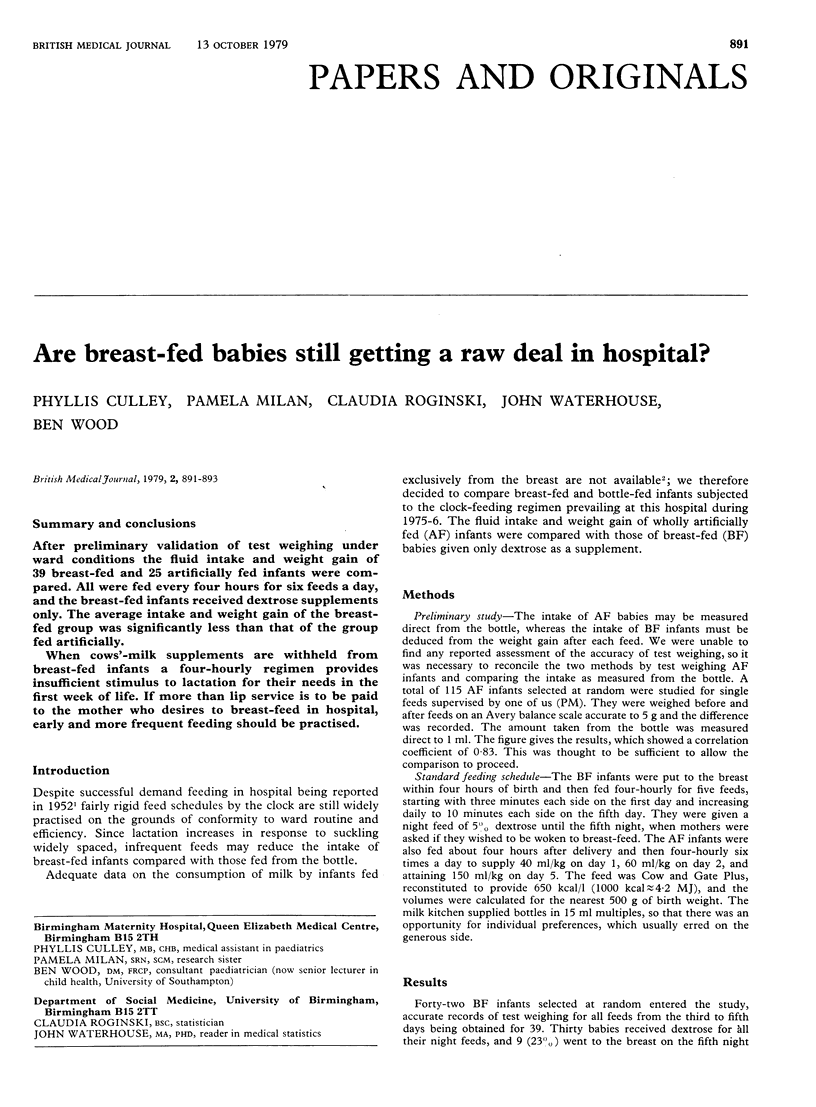Abstract
After preliminary validation of test weighing under ward conditions the fluid intake and weight gain of 39 breast-fed and 25 artificially fed infants were compared. All were fed every four hours for six feeds a day, and the breast-fed infants received dextrose supplements only. The average intake and weight gain of the breast-fed group was significantly less than that of the group fed artificially.
When cows'-milk supplements are withheld from breast-fed infants a four-hourly regimen provides insufficient stimulus to lactation for their needs in the first week of life. If more than lip service is to be paid to the mother who desires to breast-feed in hospital, early and more frequent feeding should be practised.
Full text
PDF


Selected References
These references are in PubMed. This may not be the complete list of references from this article.
- Bullen C. L., Willis A. T. Resistance of the breast-fed infant to gastroenteritis. Br Med J. 1971 Aug 7;3(5770):338–343. doi: 10.1136/bmj.3.5770.338. [DOI] [PMC free article] [PubMed] [Google Scholar]
- Campbell N., Harvey D., Norman A. P. Increased frequency of neonatal jaundice in a maternity hospital. Br Med J. 1975 Jun 7;2(5970):548–552. doi: 10.1136/bmj.2.5970.548. [DOI] [PMC free article] [PubMed] [Google Scholar]
- Cruse P., Yudkin P., Baum J. D. Establishing demand feeding in hospital. Arch Dis Child. 1978 Jan;53(1):76–78. doi: 10.1136/adc.53.1.76. [DOI] [PMC free article] [PubMed] [Google Scholar]
- Dahms B. B., Krauss A. N., Gartner L. M., Klain D. B., Soodalter J., Auld P. A. Breast feeding and serum bilirubin values during the first 4 days of life. J Pediatr. 1973 Dec;83(6):1049–1054. doi: 10.1016/s0022-3476(73)80549-9. [DOI] [PubMed] [Google Scholar]
- Eastham E., Smith D., Poole D., Neligan G. Further decline of breast-feeding. Br Med J. 1976 Feb 7;1(6005):305–307. doi: 10.1136/bmj.1.6005.305. [DOI] [PMC free article] [PubMed] [Google Scholar]
- FOMON S. J., OWEN G. M., THOMAS L. N. MILK OR FORMULA VOLUME INGESTED BY INFANTS FED AD LIBITUM. Am J Dis Child. 1964 Dec;108:601–604. doi: 10.1001/archpedi.1964.02090010603003. [DOI] [PubMed] [Google Scholar]
- Filer L. J., Jr, Fomon S. J., Thomas L. N., Rogers R. R. Growth and serum chemical values of normal breastfed infants. Acta Paediatr Scand Suppl. 1970;202(Suppl):1+–1+. doi: 10.1111/j.1651-2227.1970.tb05611.x. [DOI] [PubMed] [Google Scholar]
- Salariya E. M., Easton P. M., Cater J. I. Duration of breast-feeding after early initiation and frequent feeding. Lancet. 1978 Nov 25;2(8100):1141–1143. doi: 10.1016/s0140-6736(78)92289-4. [DOI] [PubMed] [Google Scholar]
- Wood B., Culley P., Roginski C., Powell J., Waterhouse J. Factors affecting neonatal jaundice. Arch Dis Child. 1979 Feb;54(2):111–115. doi: 10.1136/adc.54.2.111. [DOI] [PMC free article] [PubMed] [Google Scholar]


